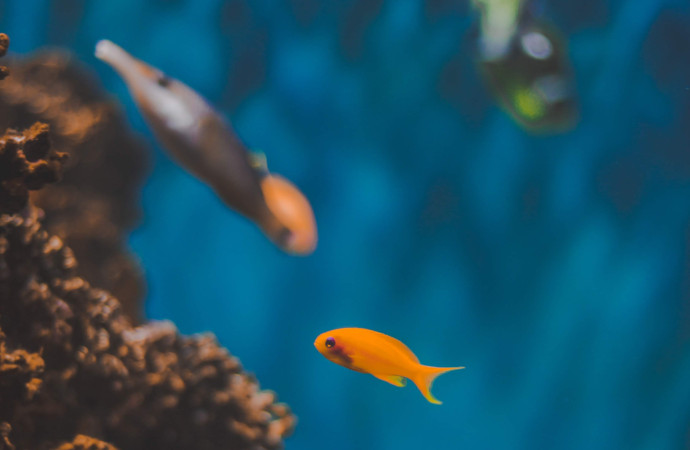Gaspar
Adaptation des espèces de poissons envahissantes dans un contexte de changement global: le cas des poissons de la Mer Rouge qui envahissent la Méditerrannée

L’invasion d’espèces non autochtones est considérée comme l’une des principales menaces pour la biodiversité, entrainant des changements importants dans la structure et le fonctionnement des écosystèmes. Dans le contexte de la globalisation, la recherche sur les espèces envahissantes est devenue de plus en plus importante du fait du nombre croissant d’espèces déplacées par l’activité humaine –transports, commerce, etc. Les espèces envahissantes sont souvent sources de problèmes, car elles entrent en compétition avec la faune ou flore locales. Elles perturbent ainsi souvent la densité et la qualité des espèces natives. Il en résulte une perte de biodiversité qui, à terme, peut engendrer des pertes importantes de services écosystémiques, comme par exemple une diminution des rendements de la pêche. Depuis l’ouverture du Canal de Suez en 1869, la Méditerranée de l’Est connait une transformation sans précédent dans la composition de ses espèces, avec l’arrivée massive d’espèces non autochtones, dites lessepsiennes, provenant de la Mer Rouge. Ces espèces constituent déjà plus du quart des captures dans l’est de la Méditerranée, et parfois bien plus. Certaines de ces espèces arrivent même aujourd’hui jusqu’en Méditerranée de l’Ouest.
Le projet Gaspar a particulièrement étudié les mécanismes qui permettent l’adaptation d’une espèce à un nouvel environnement, dans le contexte d’une invasion biologique et de l’adaptation des espèces aux changements climatiques et globaux. En effet, pour la première fois, le projet Gaspar a mené une étude sur l’ensemble des espèces habitant des systèmes limitrophes pour identifier les processus sélectionnant celles qui deviendront envahissantes. Cette information est rarement disponible et jusqu’à présent cette approche n’avait jamais été utilisée.

Porteur du projet :
Michel KULBICKI – IRD (France)
Postdoctorant :
Valeriano PARRAVICINI – IRD (France)
Le projet Gaspar réunit des spécialistes en écologie des récifs coralliens, écologie des poissons, macro-écologie, gestion de pêche, statistique et modélisation.
Le projet Gaspar est issu de l’appel à projet de 2010. Le processus de sélection du projet a été réalisé par un comité d’experts indépendants.
[29] Parravicini V, Bender MG, Villéger S, Leprieur F, Pellissier L, Donati FGA, Floeter SR, Rezende EL, Mouillot D & Kulbicki M (2021) Coral reef fishes reveal strong divergence in the prevalence of traits along the global diversity gradient. Proceedings of the Royal Society B: Biological Sciences, 288, 20211712. DOI: 10.1098/rspb.2021.1712.
[28] Yancovitch Shalom H, Granot I, Blowes SA, Friedlander AM, Mellin C, Leite Ferreira CE, Arias-González JE, Kulbicki M, Floeter SR, Chabanet P, Parravicini V & Belmaker J (2020) A closer examination of the 'abundant center' hypothesis for reef fishes. Journal of Biogeography, 47, 2194–2209. DOI: 10.1111/jbi.13920.
[27] Kulbicki M, Friedlander AM, Mouillot D & Parravicini V (2018) Geographic variation in the composition and function of parrotfishes. In: Hoey A, Bellwood DR & Bonaldo R (Eds.), The Biology and Ecology of Parrotfishes, CRC Press/Taylor & Francis Group, Boca Raton, FL, USA (pp. 215–244). DOI: 10.1201/9781315118079.
[26] Bender MG, Leprieur F, Mouillot D, Kulbicki M, Parravicini V, Pie MR, Barneche DR, Oliveira-Santos LGR & Floeter SR (2017) Isolation drives taxonomic and functional nestedness in tropical reef fish faunas. Ecography, 40, 425–435. DOI: 10.1111/ecog.02293.
[25] Jacquet C, Mouillot D, Kulbicki M & Gravel D (2017) Extensions of Island Biogeography Theory predict the scaling of functional trait composition with habitat area and isolation. Ecology Letters, 20, 135–146. DOI: 10.1111/ele.12716.
[24] Ottimofiore E, Albouy C, Leprieur F, Descombes P, Kulbicki M, Mouillot D, Parravicini V & Pellissier L (2017) Responses of coral reef fishes to past climate changes are related to life-history traits. Ecology and Evolution, 7, 1996–2005. DOI: 10.1002/ece3.2800.
[23] Barneche DR, Kulbicki M, Floeter SR, Friedlander AM & Allen AP (2016) Energetic and ecological constraints on population density of reef fishes. Proceedings of the Royal Society B: Biological Sciences, 283, 20152186. DOI: 10.1098/rspb.2015.2186.
[22] D'agata S, Mouillot D, Wantiez L, Friedlander AM, Kulbicki M & Vigliola L (2016) Marine reserves lag behind wilderness in the conservation of key functional roles. Nature Communications, 7, 12000–12009. DOI: 10.1038/ncomms12000.
[21] D'agata S, Vigliola L, Graham NAJ, Wantiez L, Parravicini V, Villéger S, Mou-Tham G, Frolla P, Friedlander AM, Kulbicki M & Mouillot D (2016) Unexpected high vulnerability of functions in wilderness areas: evidence from coral reef fishes. Proceedings of the Royal Society B: Biological Sciences, 283, 20160128. DOI: 10.1098/rspb.2016.0128.
[20] Leprieur F, Colosio S, Descombes P, Parravicini V, Kulbicki M, Cowman PF, Bellwood DR, Mouillot D & Pellissier L (2016) Historical and contemporary determinants of global phylogenetic structure in tropical reef fish faunas. Ecography, 39, 825–835. DOI: 10.1111/ecog.01638.
[19] Leprieur F, Descombes P, Gaboriau T, Cowman PF, Parravicini V, Kulbicki M, Melian CJ, de Santana CN, Heine C, Mouillot D, Bellwood DR & Pellissier L (2016) Plate tectonics drive tropical reef biodiversity dynamics. Nature Communications, 7, 11461–11468. DOI: 10.1038/ncomms11461.
[18] Mellin C, Mouillot D, Kulbicki M, McClanahan TR, Vigliola L, Bradshaw CJA, Brainard RE, Chabanet P, Edgar GJ, Fordham DA, Friedlander AM, Parravicini V, Sequeira AMM, Stuart-Smith RD, Wantiez L & Caley MJ (2016) Humans and seasonal climate variability threaten large-bodied coral reef fish with small ranges. Nature Communications, 7, 10491–10499. DOI: 10.1038/ncomms10491.
[17] Mouillot D, Parravicini V, Bellwood DR, Leprieur F, Huang D, Cowman PF, Albouy C, Hughes TP, Thuiller W & Guilhaumon F (2016) Global marine protected areas do not secure the evolutionary history of tropical corals and fishes. Nature Communications, 7, 10359–10366. DOI: 10.1038/ncomms10359.
[16] Descombes P, Wisz MS, Leprieur F, Parravicini V, Heine C, Olsen SM, Swingedouw D, Kulbicki M, Mouillot D & Pellissier L (2015) Forecasted coral reef decline in marine biodiversity hotspots under climate change. Global Change Biology, 21, 2479–2487. DOI: 10.1111/gcb.12868.
[15] Kulbicki M, Parravicini V & Mouillot D (2015) Patterns and processes in reef fish body size. In: Mora C (Eds.), Ecology of Fishes on Coral Reefs, Cambridge University Press, Cambridge, UK (pp. 104–115). DOI: 10.1017/CBO9781316105412.013.
[14] Parravicini V, Azzurro E, Kulbicki M & Belmaker J (2015) Niche shift can impair the ability to predict invasion risk in the marine realm: An illustration using Mediterranean fish invaders. Ecology Letters, 18, 246–253. DOI: 10.1111/ele.12401.
[13] Barneche DR, Kulbicki M, Floeter SR, Friedlander AM, Maina J & Allen AP (2014) Scaling metabolism from individuals to reef-fish communities at broad spatial scales. Ecology Letters, 17, 1067–1076. DOI: 10.1111/ele.12309.
[12] D'agata S, Mouillot D, Kulbicki M, Andréfouët S, Bellwood DR, Cinner JE, Cowman PF, Kronen M, Pinca S & Vigliola L (2014) Human-mediated loss of phylogenetic and functional diversity in coral reef fishes. Current Biology, 24, 555–560. DOI: 10.1016/j.cub.2014.01.049.
[11] Mouillot D, Villéger S, Parravicini V, Kulbicki M, Arias-González JE, Bender MG, Chabanet P, Floeter SR, Friedlander AM, Vigliola L & Bellwood DR (2014) Functional over-redundancy and high functional vulnerability in global fish faunas on tropical reefs. Proceedings of the National Academy of Sciences of the United States of America, 111, 13757–13762. DOI: 10.1073/pnas.1317625111.
[10] Parravicini V, Villéger S, McClanahan TR, Arias-González JE, Bellwood DR, Belmaker J, Chabanet P, Floeter SR, Friedlander AM, Guilhaumon F, Vigliola L, Kulbicki M & Mouillot D (2014) Global mismatch between species richness and vulnerability of reef fish assemblages. Ecology Letters, 17, 1101–1110. DOI: 10.1111/ele.12316.
[09] Pellissier L, Leprieur F, Parravicini V, Cowman PF, Kulbicki M, Litsios G, Olsen SM, Wisz MS, Bellwood DR & Mouillot D (2014) Quaternary coral reef refugia preserved fish diversity. Science, 344, 1016–1019. DOI: 10.1126/science.1249853.
[08] Stier AC, Hein AM, Parravicini V & Kulbicki M (2014) Larval dispersal drives trophic structure across Pacific coral reefs. Nature Communications, 5, 5575–5578. DOI: 10.1038/ncomms6575.
[07] Belmaker J, Parravicini V & Kulbicki M (2013) Ecological traits and environmental affinity explain Red Sea fish introduction into the Mediterranean. Global Change Biology, 19, 1373–1382. DOI: 10.1111/gcb.12132.
[06] Bender MG, Pie MR, Rezende EL, Mouillot D & Floeter SR (2013) Biogeographic, historical and environmental influences on the taxonomic and functional structure of Atlantic reef fish assemblages. Global Ecology and Biogeography, 22, 1173–1182. DOI: 10.1111/geb.12099.
[05] Kulbicki M, Parravicini V, Bellwood DR, Arias-González JE, Chabanet P, Floeter SR, Friedlander AM, McPherson J, Myers RE, Vigliola L & Mouillot D (2013) Global biogeography of reef fishes: A hierarchical quantitative delineation of regions. PLoS ONE, 8, e81847. DOI: 10.1371/journal.pone.0081847.
[04] Luiz OJ, Allen AP, Robertson DR, Floeter SR, Kulbicki M, Vigliola L, Becheler R & Madin JS (2013) Adult and larval traits as determinants of geographic range size among tropical reef fishes. Proceedings of the National Academy of Sciences of the United States of America, 110, 16498–16502. DOI: 10.1073/pnas.1304074110.
[03] Mouillot D, Bellwood DR, Baraloto C, Chave J, Galzin R, Harmelin-Vivien M, Kulbicki M, Lavergne S, Lavorel S, Mouquet N, Paine CET, Renaud J & Thuiller W (2013) Rare species support vulnerable functions in high-diversity ecosystems. PLoS Biology, 11, e1001569. DOI: 10.1371/journal.pbio.1001569.
[02] Mouillot D, de Bortoli J, Leprieur F, Parravicini V, Kulbicki M & Bellwood DR (2013) The challenge of delineating biogeographical regions: Nestedness matters for Indo-Pacific coral reef fishes. Journal of Biogeography, 40, 2228–2237. DOI: 10.1111/jbi.12194.
[01] Parravicini V, Kulbicki M, Bellwood DR, Friedlander AM, Arias-González JE, Chabanet P, Floeter SR, Myers RE, Vigliola L, D'agata S & Mouillot D (2013) Global patterns and predictors of tropical reef fish species richness. Ecography, 36, 1254–1262. DOI: 10.1111/j.1600-0587.2013.00291.x.